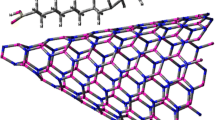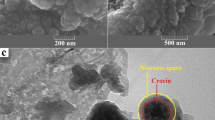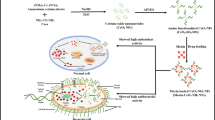Abstract
In this study, the antioxidant activity of crocin via experimental and theoretical methods was investigated. In order to induce oxidative stress, 30-min renal ischemia and 24-h reperfusion were used in male Wistar rats. Oxidative stress was assessed by measuring tissue malondialdehyde (MDA) and ferric reducing/antioxidant power (FRAP). The results showed that following ischemia/reperfusion, the level of MDA was increased and FRAP decreased. Both of these changes were alleviated by crocin administration. The bond dissociation enthalpy and ionization potential values as enthalpies of mechanism of antioxidant activity of crocin were calculated by density functional theory method. According to obtained results, the novel structures of crocin with higher antioxidant activity for synthesis were proposed. Results indicated that NH2, OMe, and F substituents can improve the antioxidant activity of crocin. The crocin delivery via carbon and boron nitride nanotubes and nanocones was investigated. The results confirm that the calculated adsorption and free Gibbs energies of crocin on the surface of studied nanostructures were negative meaningfully, so these processes were exothermic and experimentally possible from the energetic viewpoint.





Similar content being viewed by others
Abbreviations
- PBS:
-
phosphate buffer saline
- MDA:
-
malondialdehyde
- FRAP:
-
ferric reducing/antioxidant power
- DFT:
-
density functional theory
- PW91:
-
Perdew–Wang 91
- HOMO:
-
highest occupied molecular orbital
- LUMO:
-
lowest unoccupied molecular orbital
- HLG:
-
HOMO–LUMO gap
- CNC:
-
carbon nanocone
- BNNC:
-
boron nitride nanocone
- CNT:
-
carbon nanotube
- BNNT:
-
boron nitride nanotube
- BDE:
-
bond dissociation enthalpy
- IP:
-
ionization potential
- HAT:
-
hydrogen atom transfer
- SET:
-
single electron transfer
References
Karrer, P., F. Benz, R. Morf, and H. Raudnitz. 1932. Helvetica Chimica Acta 15: 1399.
Isler, O. 1979. Pure and Applied Chemistry 51: 447–462.
Hosseinzadeh, H., T. Ziaee, and A. Sadeghi. 2008. Phytomedicine 15: 491–495.
Laabich, A., and G.P. Vissvesvaran. 2006. Investigative Ophthalmology & Visual Science 47: 3156–3163.
Papandreou, M.A., C.D. Kanakis, and M. Margarity. 2006. Journal of Agricultural and Food Chemistry 54: 8762–8768.
Shinji, S., T. Ochiai, H. Shimeno, H. Saito, and K. Abe. 2007. Journal of Natural Medicines 61: 102–111.
Edge, R., D.J. McGarvey, and T.G. Truscott. 1997. Journal of Photochemistry and Photobiology. B 41: 189–200.
Woodall, A.A., S.W.M. Lee, and R.J. Weesie. 1997. Biochimica et Biophysica Acta 1336: 33–42.
Guo, J., Y. Luo, and F. Himo. 2002. Chemical Physics Letters 366: 73–81.
Chen, Y., H. Zhang, C. Zhao, L. Cai, Y. Liu, and L. Jia. 2008. Food Chemistry 109: 484–492.
Najafi, M., M. Najafi, and H. Najafi. 2012. Bulletin of the Korean Chemical Society 33: 3343–3348.
Najafi, M., M. Najafi, and H. Najafi. 2012. Bulletin of the Korean Chemical Society 33: 3607–3617.
Iijima, S. 1991. Nature 354: 56–58.
Kong, J., N.R. Franklin, C. Zhou, and M.G. Chapline. 2000. Science 287: 622–625.
Collins, P.G., K. Bradley, and M. Ishigami. 2000. A. Science 287: 1801–1804.
Snow, E.S., F.K. Perkins, and J.A. Robinson. 2006. Chemical Society Reviews 35: 790–798.
Kauffman, D.R., and A. Star. 2008. Ang. Chemistry International 47: 6550–6570.
Russo, G.L., M. Russo, and I. Castellano. 2014. Marine Drugs 12 (7): 4069–4085.
Sieliwoniuk, E.N., and J. Malejko. Food Chemistry 176: 175–183.
Veloso, M.V., A.G. Souza Filho, and Filho Mendes. Journal Chemistry Physics Letters: 430–471.
Meng, L., X. Zhang, Q. Lu, Z. Fei, and P.J. Dyson. 2012. Biomaterials 33: 1689–1698.
Cuevas-Glory, L., and E. Ortiz-Vázquez. 2015. Mexico. Food Chemistry 166: 17–22.
Mahmoudzadeh, L., H. Najafi, S. Changizi-Ashtiyani, and Z. Mohamadi Yarijani. 2016. Nephrology.
Najafi, H., M.R. Firouzifar, O. Shafaat, S. Changizi Ashtiyani, and N. Hosseini. 2014. Iranian Journal of Kidney Diseases 8: 293–298.
Najafi, H., S.M. Owji, E. Kamali-Sarvestani, and S.M. Shid Moosavi. 2016. Experimental Physiology 101 (7): 913–931.
Máté, S., and J. Nie. 2010. Surface Science 604: 654.
Oubal, M., S. Picaud, M. Rayez, and J. Rayez. 2010. Surface Science 604: 1666.
Ferro, Y., A. Allouche, F. Marinelli, and C. Bros. 2004. Sets Surface Science 559: 158.
Grimme, S. 2006. Journal of Computational Chemistry 27: 1787.
Schmidt, M., et al. 1993. Journal of Computational Chemistry 14: 1347.
Najafi, M., M. Najafi, and H. Najafi. 2013. Journal of Theoretical and Computational Chemistry 12: 1250116.
Najafi, M., M. Najafi, and H. Najafi. 2013. Bulletin of the Chemical Society of Japan 86: 497–509.
Najafi, M., M. Najafi, and H. Najafi. 2013. Computational & Theoretical Chemistry 999: 34–42.
Najafi, M., M. Najafi, and H. Najafi. 2012. Canadian Journal of Chemistry 90: 915–926.
Acknowledgments
The experimental results described in this paper were part of research project No 91077. The authors would like to thank the Vice-Chancellery for research affairs of Kermanshah University of Medical Sciences for financial support.
Author information
Authors and Affiliations
Corresponding author
Rights and permissions
About this article
Cite this article
Najafi, H., Yarijani, Z.M. & Najafi, M. Theoretical and Experimental in vivo Study of Antioxidant Activity of Crocin in Order to Propose Novel Derivatives with Higher Antioxidant Activity and Their Delivery via Nanotubes and Nanocones. Inflammation 40, 1794–1802 (2017). https://doi.org/10.1007/s10753-017-0623-4
Published:
Issue Date:
DOI: https://doi.org/10.1007/s10753-017-0623-4




